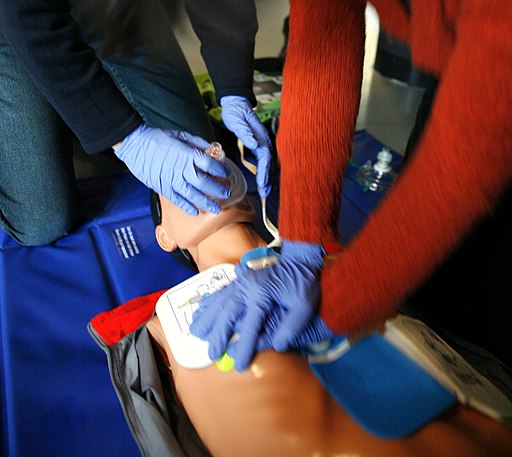 |
| (Image by Rama (Own work) [CC BY-SA 2.0 fr (http://creativecommons.org/licenses/by-sa/2.0/fr/deed.en)], via Wikimedia Commons) |
It is an emergency procedure in cardiac arrest to maintain the blood flow to the brain and vital organs by compressing chest manually in an unconscious patient with no pulse and no breathing or abnormal breathing such as agonal gasping.
During CPR in an emergency, one has to focus on critical concepts such as
- push hard and fast
- allow maximum chest recoil during compression
- compression a rate of at least 100/min
- should not interrupt compression often or for long
- Ensure the scene is safe
- Rescuers should wear gloves
- Keep the patient in supine position and on a flat and firm surface
- Remove the clothes from the chest of the patient
- Keep the heel of the one hand on the middle and center of the chest and place the other hand on the top of it with fingers intertwined ( draw an imaginary line between the nipples)
- Push hard and fast and count it loudly
- For adults- 2 inch/ 5 cm
- For children-2 inch/ 5 cm
- For infants- 1.5 inch/ 4 cm
- If the rescuer's hands and wrists are arthritic, keep one hand on the chest and grasp the wrist of the hand with the other hand to support it for deep chest compression. This technique may be useful to push hard and fast.
Can u pls tel me d ratio for CPR in case of adults and pediatric ?
ReplyDeleteHi Dhyan,
ReplyDeleteFor adults, 30:2 ratio has to be maintained by 1- or 2-rescuer, which means after 30 compression, rescuer should deliver two breaths.
For children and infants, 30:2 for 1-rescuer CPR and 15:2 for 2-rescuer CPR.
Thank you very much...
thanks mam
ReplyDeleteNice Article. First Aid Course is really important to everyone. It can save life and it also promote recovery. If you want to learn more about cardiopulmonary resuscitation. See More
ReplyDelete